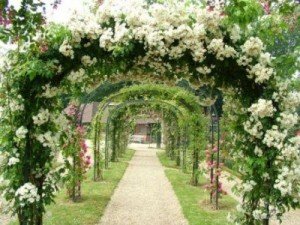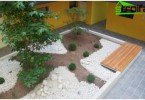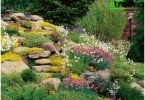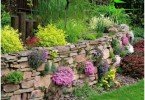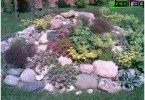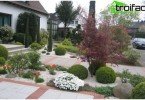How to install wood and metal pergolas
A do-it-yourself pergola can decorate the garden well. With its help, cozy recreation areas are equipped, they hide the disadvantages of the site. These structures are made of various materials, the choice of which is determined by the general style of the garden. The most popular are wooden, metal and combined pergolas, which are used for climbing plants..
Content
- The use of pergolas for the garden and their design
- The installation process of traditional wooden pergolas
- Other types of wooden pergolas
- Pergola metal constructions and weaving plants selection
The use of pergolas for the garden and their design
Since ancient times, beautiful plants, herbs, ornamental shrubs and trees were used to decorate the garden. Various arbors, bridges, trellises, garden furniture and, of course, pergolas look spectacularly in all this natural splendor. They are a construction on which weaving plants such as grapes, hops, climbing roses, creeping hydrangeas and others.
Pregolas have their own functional purpose – they are needed to create a cozy corner. Inside this design, you can put garden furniture, but more often they are used to beautifully frame the paths. In addition, pergolas are good if necessary to visually hide some of the shortcomings of the site or building.
The most common were wooden, forged, plastic structures. There are structures of one type of material and mixed, for example, with a metal frame and a wooden crate on top. As a rule, garden pergolas are several arches, paired pillars or frames connected together. The top of the structure can be flat or rounded..
Having set the goal to build wooden pergolas with your own hands, it is necessary to remember that such a design, taking into account the presence of a plant, must withstand strong wind gusts. As a support, metal, wooden, stone, concrete or brick pillars are used, while it is advisable to seal them in foundation glasses.
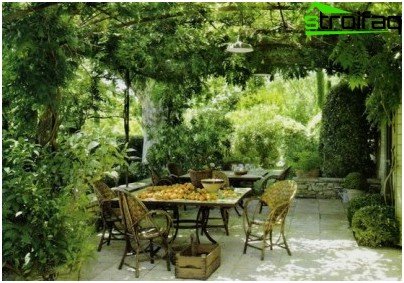
Pergola can be a great place to relax
The installation process of traditional wooden pergolas
Wooden pergolas can be divided into several popular types: traditional, oriental, rustic, wall. To create a traditional design, pine or larch beams with a minimum cross section of 10×10 cm are required. Answering the question of how to make a pergola with your own hands, we note that the work should begin with the installation of supports. To do this, dig holes, at the bottom of which a layer of stone or broken brick is poured (drainage). The lower parts of wooden posts need to be coated with tar or bitumen. Such measures will allow the pergola to function for a long time and protect it from rot.
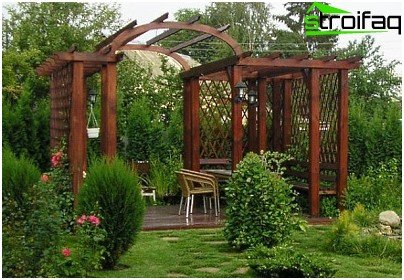
For a wooden pergola to serve for a long time, it is imperative to process the wood
Next, a pillar is installed and fixed with temporary supports. The pit is poured with concrete mortar. Be sure to check the level of verticality of the installation. The solution is compacted, giving the top a conical shape. This is necessary so that rainwater does not accumulate at the base. Further work should be done 8 to 10 days after concreting..
The assembly of the top begins with the marking and cutting of the spikes and grooves. It is important to note that the roof beams should protrude 15 – 30 cm from the outer edge of the uprights, which will make the structure correct and beautiful. Before fixing the parts, it is worthwhile to carry out a control assembly, having fitted all the structural elements. Fasten the supports to the top with screws. For reliability, it is advisable to coat joints with waterproof glue. Be sure to carry out an antiseptic treatment.
Other types of wooden pergolas
Oriental-style structures differ from traditional pergolas in that the transverse beams with beveled ends are located in the main supports using grooves. You can enhance the effect if the ends of the beams are not just beveled, but bent up.
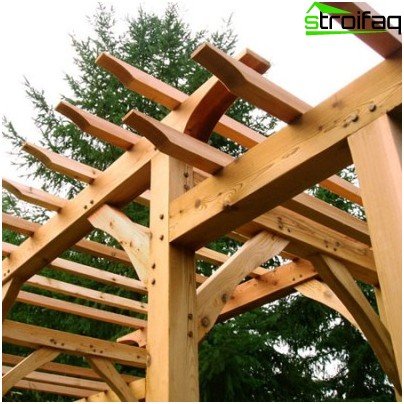
Oriental-style pergola with transverse beveled beams
Curly roses are a great choice for pergolas. These flowers can decorate any garden..
For the traditional layout, rustic pergolas are used, which have some features. This design is less durable compared to others, therefore, requires the mandatory fit of parts on waterproof glue. Strengthen stiffness with spacers between posts.
Beautiful compositions are created using curly vines of grapes. This gorgeous plant will delight not only juicy fruits, but also a pleasant shadow in the summer heat. Pergola for grapes may well be wall. Fasten roof beams in two ways:
- using brackets;
- on anchor bolts every 50 cm attach a wooden beam with a section of 15 * 5 cm, the length of which is determined by the size of the pergola. Then fix the beams using U-shaped brackets with an interval of 70 cm. For an inclined roof, it is necessary to make bevels on the upper edge of the beam.
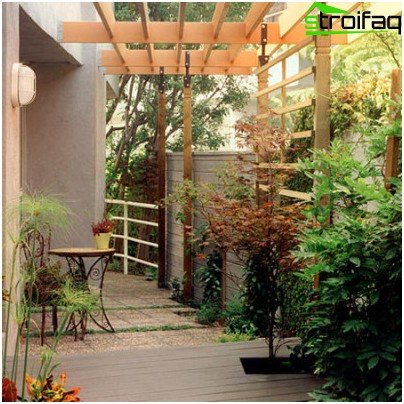
Wall pergola creates a cozy and colorful corner near the house
If you want to improve the roof structure with transverse beams, choose thinner boards (for example, 10×2.5 cm) from soft varieties of wood. Their ends can be decorated with ornaments and placed so that they protrude 30 – 40 cm. Fasteners are carried out on U-shaped staples.
Pergola metal constructions and weaving plants selection
Metal pergolas look light and beautiful. They are quite popular because they are durable, easy to install and operate. For the construction, bent pipes, profiles, steel reinforcement of the most diverse type and section are used. Something can be made even at home, but certain types of work should be entrusted to specialists. For example, it’s very difficult to make several even and identical arches yourself.
In any case, forged pergolas must be ordered by experienced blacksmiths. But the appearance of such structures is distinguished by grace. Art forging allows you to create interesting compositions, include various decorative elements. You can create a relaxation area by adding several chairs and a table made in the same style..
Knowing how to build a pergola and where to place it, you should also decide on the plants that will entwine it. For shady areas suitable: lemongrass, kirkazon, hops, wood pliers. Penumbra loves actinidia and creeping hydrangea, and the southern sunny areas are great for clematis, grapes and climbing roses.
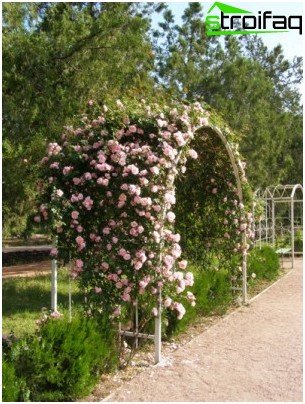
A great option for climbing plants are sun-loving roses
For those who do not have such a design in their garden, colorful photos of the pergola can be a good motivation in favor of the decision to place such a building. After all, a beautiful and bright corner, where you can relax, every person needs.
Designs for the garden can be ordered, or can be done with your own hands. Pergola is capable of even not very experienced owners. To create it, wood, metal are most often used, and various materials are also combined. Forged options have a special grace, however, you always need to look at the general style of the garden and then decide which particular pergola is best suited.


